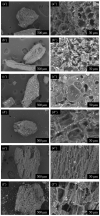A Network of Processes for Biorefining Burdock Seeds and Roots
- PMID: 38474449
- PMCID: PMC10934740
- DOI: 10.3390/molecules29050937
A Network of Processes for Biorefining Burdock Seeds and Roots
Abstract
In this work, a novel sustainable approach was proposed for the integral valorisation of Arctium lappa (burdock) seeds and roots. Firstly, a preliminary recovery of bioactive compounds, including unsaturated fatty acids, was performed. Then, simple sugars (i.e., fructose and sucrose) and phenolic compounds were extracted by using compressed fluids (supercritical CO2 and propane). Consequently, a complete characterisation of raw biomass and extraction residues was carried out to determine the starting chemical composition in terms of residual lipids, proteins, hemicellulose, cellulose, lignin, and ash content. Subsequently, three alternative ways to utilise extraction residues were proposed and successfully tested: (i) enzymatic hydrolysis operated by Cellulases (Thricoderma resei) of raw and residual biomass to glucose, (ii) direct ethanolysis to produce ethyl levulinate; and (iii) pyrolysis to obtain biochar to be used as supports for the synthesis of sulfonated magnetic iron-carbon catalysts (Fe-SMCC) to be applied in the dehydration of fructose for the synthesis of 5-hydroxymethylfurfural (5-HMF). The development of these advanced approaches enabled the full utilisation of this resource through the production of fine chemicals and value-added compounds in line with the principles of the circular economy.
Keywords: 5-hydroxymethylfurfural; Arctium lappa; biomass valorization; burdock roots; burdock seeds; circular economy; enzymatic hydrolysis; ethyl levulinate.
Conflict of interest statement
All authors declare that the research was conducted in the absence of any commercial or financial relationships that could be construed as a potential conflict of interest.
Figures







Similar articles
-
Metabolic profile of the bioactive compounds of burdock (Arctium lappa) seeds, roots and leaves.J Pharm Biomed Anal. 2010 Jan 20;51(2):399-404. doi: 10.1016/j.jpba.2009.03.018. Epub 2009 Mar 25. J Pharm Biomed Anal. 2010. PMID: 19375261
-
Comparative analysis of caffeoylquinic acids and lignans in roots and seeds among various burdock (Arctium lappa) genotypes with high antioxidant activity.J Agric Food Chem. 2012 Apr 25;60(16):4067-75. doi: 10.1021/jf2050697. Epub 2012 Apr 12. J Agric Food Chem. 2012. PMID: 22497441
-
Assessment of Ethanolic Extraction of Chlorogenic Acid, Cynarin, and Polyphenols from Burdock (Arctium lappa L.) Roots Under Ultrasound.Molecules. 2024 Oct 30;29(21):5115. doi: 10.3390/molecules29215115. Molecules. 2024. PMID: 39519756 Free PMC article.
-
Burdock (Arctium lappa L) roots as a source of inulin-type fructans and other bioactive compounds: Current knowledge and future perspectives for food and non-food applications.Food Res Int. 2021 Mar;141:109889. doi: 10.1016/j.foodres.2020.109889. Epub 2020 Nov 10. Food Res Int. 2021. PMID: 33641945 Review.
-
Phytochemicals and Biological Activities of Burdock (Arctium lappa L.) Extracts: A Review.Chem Biodivers. 2022 Nov;19(11):e202200615. doi: 10.1002/cbdv.202200615. Epub 2022 Nov 3. Chem Biodivers. 2022. PMID: 36198078 Review.
References
-
- Petkova N., Hambarlyiska I., Tumbarski Y., Vrancheva R., Raeva M., Ivanov I. Phytochemical composition and antimicrobial properties of burdock (Arctium lappa L.) roots extracts. Biointerface Res. Appl. Chem. 2022;12:2826–2842. doi: 10.33263/BRIAC123.28262842. - DOI
MeSH terms
Substances
Grants and funding
LinkOut - more resources
Full Text Sources
Research Materials
Miscellaneous

